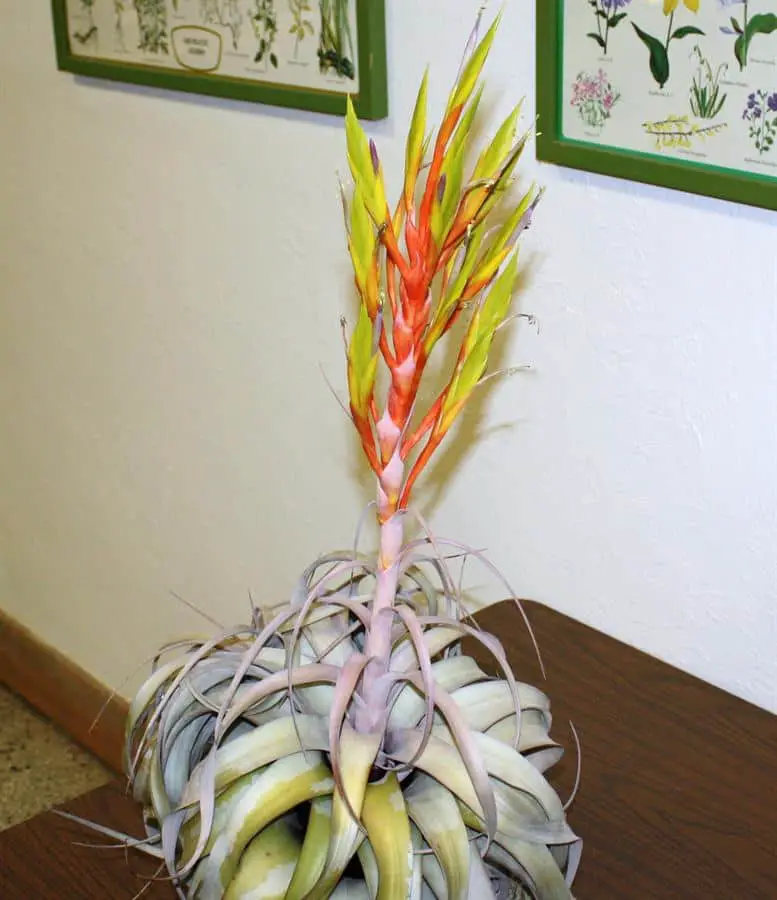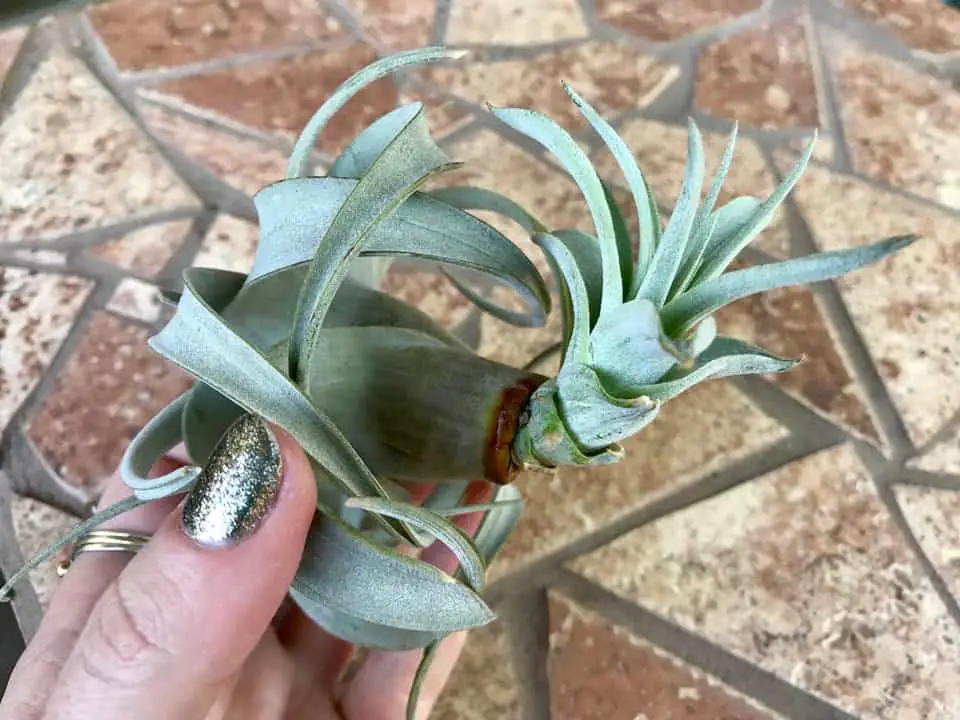Tillandsia xerographica, which is commonly referred to as the King of the Air Plants, is one of the most commonly available types of air plants. It is easy to see why they are so popular. They make a stunning addition to a bowl or simply placed on a coffee table. Not only do xerographica plants make a beautiful addition to modern decor, but they are also low maintenance plants. So how do you care for these plants?
Tillandsia xerographica To properly care for these plants, they should be placed in a location that receives plenty of bright sunlight. Like other xeric air plants, Tillandsia xerographica prefers frequent misting to soaks. After watering, put the xerographica plant upside down in a sunny area in order to minimize the chance of rot. Finally, Tillandsia xerographica can be fertilized using a low-nitrogen fertilizer made for air plants. It is best to fertilize once or twice during the growing season (spring and summer).
The rest of this blog post will be a detailed guide that outlines how to take care of your Tillandsia xerographica. If properly cared for, you can enjoy these plants for many years.
About Tillandsia xerographica
Tillandsia xerographica is an air plant that belongs to the Bromeliaceae family and is endemic to the dry tropical forests of the Mesoamerican Region (El Salvador, Honduras, Guatemala). The table below summarizes the conditions in this plant’s natural habitat (Garcia and Chocano, 2008).
| Altitude | 140-600 m | 460-1970 feet |
| Average Temperature | 22-28°C | 68-82°F |
| Annual Precipitation | 550-800 mm | 22-31.5 inches |
| Relative Humidity | 60-72% | 60-72% |
| Evapotranspiration | 600-800 mm/year | 24-31.5 inches/year |
Tillandsia xerographica has light, mossy green colored leaves with a silvery tint. These plants can live up to 20 years and can grow up to three feet in diameter. The xerographica plants you see at the store are usually between 3 and 5 years old.
In the wild, Tillandsia xerographica plants grow on the highest branches where it is exposed to direct, intense lighting.
Tillandsia xerographica Blooms
Eventually, xerographica plants produce an inflorescence that grows to a height of 6 to 15 inches. This bloom, which the plant only produces one time during its lifetime, is red and chartreuse. It takes the plant many years to bloom, but the inflorescence lasts for several months once it blooms.

Some commercial air plant growers encourage Tillandsias to bloom early using special chemicals such as ethylene gas, Florel, Omaflora, and Ethrel. Unfortunately, these chemicals can disrupt pup formation. You can also encourage your xerographica plant to bloom early by placing the plant in an airtight plastic bag with a sliced apple for 2-3 days. The ethylene gas, which is the only naturally occurring gaseous plant growth hormone, produced by the apple will encourage the plant to bloom.
Tillandsia xerographica Pup Formation
Pup formation is a fairly slow process after the flower dies. Over the course of a couple of years, 1-3 pups will begin to form at the base of the plant, and the mother will die. You should not remove pups until they are about 1/2 of the size of the mother plant. Removing pups too early decreases the chance of the plant’s survival. It is important to note that xerographica plants that are neglected after the flower has died have a small chance of producing pups.
Tillandsia xerographica will produce pups immediately if they experience a “traumatic” event that threatens their survival. For example, the Tillandsia xerographica shown in the picture below experienced some frost damage and began to produce a pup before blooming.

Lighting Requirements For Tillandsia xerographica
Tillandsia xerographica can handle direct sunlight, but you should avoid exposing your xerographica plant to direct, intense sunlight after watering. This could burn the leaves.
Watering Tillandsia xerographica
It is true that air plants absorb water from the air. However, they still need supplemental watering. The amount of water, as you may expect, depends on the type of air plant. Tillandsia xerographica is a xeric plant, which means that it is native to a drier climate. Like other xeric air plants, xerographica plants prefer frequent mistings to soaks.
However, many people have kept their air plants happy for years by soaking them rather than misting them. No matter what watering method you use, it is very important to give your air plant plenty of time to dry after watering. I like to leave my Tillandisa xerographica upside down near a sunny window for about 2 days after watering. This prevents rot because water is less likely to stay trapped in the leaves.
Ideally, it is best to use filtered water on your air plants (including Tillandsia xerographica). Air plants are sensitive to the chlorine content of tap water. However, you should NEVER water your air plant (or any other plant) using distilled water. Distilled water does not contain nutrients. As a result, a process called reverse osmosis will remove nutrients from the plant and possibly kill it!
During the warmer months, consider putting your Tillandsia xerographica outside during a rain storm. The plant will greatly appreciate this as that kind of environment mimics its natural habitat.
Your watering habits will also impact the leaf shape. If you allow your xerographica plant to dry out a bit, the leaves will form a curly shape. In contrast, well-hydrated xerographica plants will have straight leaves.
Fertilizing Tillandsia xerographica
Before I discuss the fertilization needs of Tillandsia xerographica, let’s talk about how air plants get the nutrients they need to survive in their natural habitat. Air plants use the trichomes on their leaves to absorb nutrients from various sources. That is why they do not need roots to survive. For example, air plants such as Tillandsia xerographica, obtain minerals from rainfall and extract nutrients from plant debris. They can even get nutrients from animal debris. In the wild, ants will make their home within the leaves of air plants. Interestingly, air plants are able to extract nutrients from the debris left behind by ants. In this way, the ants and the air plant form a symbiotic relationship.
In general, air plants are able to obtain enough nutrients from the air to survive within your home, so you do not really have to fertilize them. However, they do not have access to the plant and animal debris that is typically available in their natural habitat. Fertilization is a good way to provide these nutrients in order to encourage the plant to grow larger. Low-nitrogen fertilizers made for bromeliads are best. This is because low-nitrogen fertilizers encourage blooming and pup production.
I recommend fertilizing your Tillandsia xerographica once or twice during the spring and summer seasons. You should fertilize during a regular watering session and dilute the fertilizer before use to prevent fertilizer burn.
Is Tillandsia xerographica an endangered species?
During the 1980s, Tillandsia xerographica became so popular that they nearly went extinct. To keep up with the popularity, air plant sellers had to collect specimens from the wild. This is because air plants take between 3 and 5 years to propagate from seed, and nurseries could not keep up with the demand.
Today, the air plant trade is much more heavily regulated to prevent these plants from going extinct. The Convention on International Trade in Endangered Species of Wild Fauna and Flora (CITES) put Tillandsia xerographica on their endangered/protected species list. It is one of seven plants placed on these lists. Today, all of the Tillandsia xerographica plants purchased in stores are grown in nurseries rather than in the wild.
Learn More About Tillandsia xerographica
To learn more about air plants, check out my complete guide to caring for air plants.
Related Questions
Are Tillandsias monocarpic?
Yes, Tillandsias, which are commonly known as air plants, are monocarpic. Monocarpic plants flower once during their life cycle then die. Like many monocarpic plants, the leaves of a Tillandsias will turn a red or pink color when they are ready to bloom.
Can Tillandsia xerographica be grown outside?
Tillandsia xerographica can be kept outside during the warm summer months. In some parts of the United States, such as the southwest and parts of Florida, they can live outside all year. Xerographica plants can handle cooler temperatures, but they cannot withstand freezing temperatures. They are winter hardy in USDA Hardiness Zones 9 through 11.

